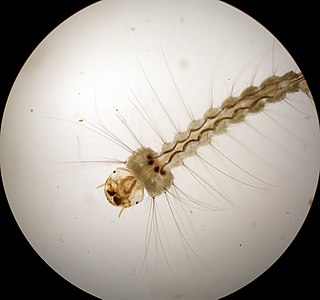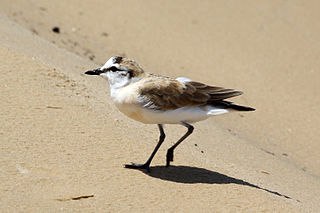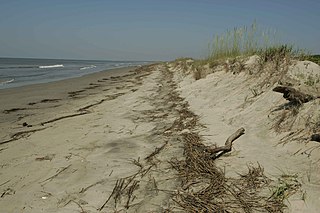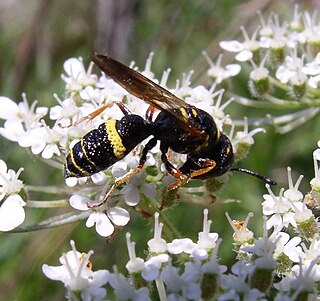
Beetles are insects that form the order Coleoptera, in the superorder Holometabola. Their front pair of wings are hardened into wing-cases, elytra, distinguishing them from most other insects. The Coleoptera, with about 400,000 described species, is the largest of all orders, constituting almost 40% of described insects and 25% of all known animal species; new species are discovered frequently, with estimates suggesting that there are between 0.9 and 2.1 million total species. Found in almost every habitat except the sea and the polar regions, they interact with their ecosystems in several ways: beetles often feed on plants and fungi, break down animal and plant debris, and eat other invertebrates. Some species are serious agricultural pests, such as the Colorado potato beetle, while others such as Coccinellidae eat aphids, scale insects, thrips, and other plant-sucking insects that damage crops.

Ghost crabs are semiterrestrial crabs of the subfamily Ocypodinae. They are common shore crabs in tropical and subtropical regions throughout the world, inhabiting deep burrows in the intertidal zone. They are generalist scavengers and predators of small animals. The name "ghost crab" derives from their nocturnality and their generally pale coloration. They are also sometimes called sand crabs, though the name refers to various other crabs that do not belong to the subfamily.

Gobiidae or gobies is a family of bony fish in the order Gobiiformes, one of the largest fish families comprising more than 2,000 species in more than 200 genera. Most of gobiid fish are relatively small, typically less than 10 cm (3.9 in) in length, and the family includes some of the smallest vertebrates in the world, such as Trimmatom nanus and Pandaka pygmaea, Trimmatom nanus are under 1 cm long when fully grown, then Pandaka pygmaea standard length are 9 mm (0.35 in), maximum known standard length are 11 mm (0.43 in). Some large gobies can reach over 30 cm (0.98 ft) in length, but that is exceptional. Generally, they are benthic or bottom-dwellers. Although few are important as food fish for humans, they are of great significance as prey species for other commercially important fish such as cod, haddock, sea bass and flatfish. Several gobiids are also of interest as aquarium fish, such as the dartfish of the genus Ptereleotris. Phylogenetic relationships of gobiids have been studied using molecular data.

The rove beetles are a family (Staphylinidae) of beetles, primarily distinguished by their short elytra that typically leave more than half of their abdominal segments exposed. With over 66,000 species in thousands of genera, the group is the largest family in the beetle order, and one of the largest families of organisms. It is an ancient group, with fossilized rove beetles known from the Triassic, 200 million years ago, and possibly even earlier if the genus Leehermania proves to be a member of this family. They are an ecologically and morphologically diverse group of beetles, and commonly encountered in terrestrial ecosystems.

Hydrophilidae, also known colloquially as water scavenger beetles, is a family of beetles. Aquatic hydrophilids are notable for their long maxillary palps, which are longer than their antennae. Several of the former subfamilies of Hydrophilidae have recently been removed and elevated to family rank; Epimetopidae, Georissidae, Helophoridae, Hydrochidae, and Spercheidae. While the majority of hydrophilids are aquatic, around a third of described species are terrestrial, mostly belonging to the subfamily Sphaeridiinae.

Histeridae is a family of beetles commonly known as clown beetles or hister beetles. This very diverse group of beetles contains 3,900 species found worldwide. They can be easily identified by their shortened elytra that leaves two of the seven tergites exposed, and their geniculate (elbowed) antennae with clubbed ends. These predatory feeders are most active at night and will fake death if they feel threatened. This family of beetles will occupy almost any kind of niche throughout the world. Hister beetles have proved useful during forensic investigations to help in time of death estimation. Also, certain species are used in the control of livestock pests that infest dung and to control houseflies. Because they are predacious and will even eat other hister beetles, they must be isolated when collected.

The Namaqua chameleon is a ground-living lizard found in the western desert regions of Namibia, South Africa and southern Angola.

In zoology, an inquiline is an animal that lives commensally in the nest, burrow, or dwelling place of an animal of another species. For example, some organisms, such as insects, may live in the homes of gophers or the garages of humans and feed on debris, fungi, roots, etc. The most widely distributed types of inquiline are those found in association with the nests of social insects, especially ants and termites – a single colony may support dozens of different inquiline species. The distinctions between parasites, social parasites, and inquilines are subtle, and many species may fulfill the criteria for more than one of these, as inquilines do exhibit many of the same characteristics as parasites. However, parasites are specifically not inquilines, because by definition they have a deleterious effect on the host species, while inquilines have not been confirmed to do so.

The white-fronted plover or white-fronted sandplover is a small shorebird of the family Charadriidae that inhabits sandy beaches, dunes, mudflats and the shores of rivers and lakes in sub-saharan Africa and Madagascar. It nests in small shallow scrapes in the ground and lays clutches of one to three eggs. The species is monogamous and long-lived, with a life expectancy of approximately 12 years. The vast majority of pairs that mate together stay together during the following years of breeding and retain the same territory. The white-fronted plover has a similar appearance to the Kentish plover, with a white fore crown and dark bands connecting the eyes to the bill.

The wrack zone or wrack line is a coastal feature where organic material and other debris are deposited at high tide. This zone acts as a natural input of marine resources into a terrestrial system, providing food and habitat for a variety of coastal organisms.

Philanthus gibbosus, the hump-backed beewolf, is a species of bee-hunting wasp and is the most common and widespread member of the genus in North America. P. gibbosus is of the order Hymenoptera and the genus Philanthus. It is native to the Midwestern United States and the western Appalachians. P. gibbosus are often observed to visit flowers and other plants in search of insect prey to feed their young. The prey that P. gibbosus catches is then coated in a layer of pollen and fed to the young wasps.

Coccinellidae is a widespread family of small beetles. They are commonly known as ladybugs in North America and ladybirds in the United Kingdom; "lady" refers to mother Mary. Entomologists use the names ladybird beetles or lady beetles to avoid confusion with true bugs. The more than 6,000 described species have a global distribution and are found in a variety of habitats. They are oval beetles with a domed back and flat underside. Many of the species have conspicuous aposematic (warning) colours and patterns, such as red with black spots, that warn potential predators that they taste bad.

Ocypode gaudichaudii, also known as the painted ghost crab or cart driver crab, is a species of crab found on Pacific beaches from El Salvador to Chile as well as on the Galápagos Islands. The species was first described by Henri Milne-Edwards and Hippolyte Lucas in 1843.

Broscus cephalotes is a species of nocturnal, coastal ground beetle found throughout most of Europe. Its range spans from western Europe into western Siberia. The species was introduced recently in the eastern areas of Canada and has spread farther south and west into the United States. As a member of the family Carabidae, Broscus cephalotes is generally considered beneficial to humans due to its predatory habits. Their varied diet often includes crop pests and other small organisms.

Dasycerinae is a subfamily of rove beetles. Dasycerinae currently only contains 1 extant genus and 3 extinct genera.
Stenus palposus is a species of beetle of the subfamily Steninae in the family Staphylinidae. As a predatory insect, it feeds on other smaller arthropods such as springtails.

Abdopus aculeatus is a small octopus species in the order Octopoda. A. aculeatus has the common name of algae octopus due to its typical resting camouflage, which resembles a gastropod shell overgrown with algae. It is small in size with a mantle around the size of a small orange and arms 25 cm in length, and is adept at mimicking its surroundings.

Symphiles are insects or other organisms which live as welcome guests in the nest of a social insect by which they are fed and guarded. The relationship between the symphile and host may be symbiotic, inquiline or parasitic.

Habroscelimorpha dorsalis, commonly known as the eastern beach tiger beetle, is a species of flashy tiger beetle in the family Cicindelidae. It is found in Central America and North America.

Habroscelimorpha dorsalis dorsalis, commonly known as the northeastern beach tiger beetle, is the largest subspecies of eastern beach tiger beetle. In 2012, Cicindela dorsalis dorsalis was reclassified under the name Habroscelimorpha dorsalis dorsalis, but the names are used synonymously in recently published literature. Fitting to its common name, the northeastern beach tiger beetle dwells along the U.S. northeast coast in small sand burrows. The beetle is diurnal and can be spotted by its light tan coloring with dark lines and green hues on its thorax and head.


















